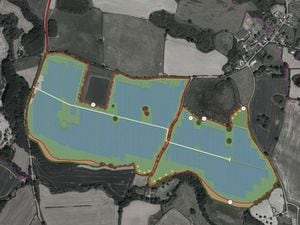Planning inquiry starts over rejected solar farm near Shrewsbury
Residents of a Shropshire village near a proposed solar farm made impassioned pleas to government inspectors as a public planning inquiry got underway on Tuesday.

The fate of a 30-megawatt solar array on land west of Berrington, near Shrewsbury, will be decided this week during a five-day hearing, triggered by Econergy International Ltd’s decision to appeal against the refusal of the original scheme last year.
The authority’s planning committee threw out the plans in May 2023, overriding the recommendations of planning officers, due to the loss of high grade agricultural land and what they described as the adverse visual impact of the development.
The site’s location as a nesting site for threatened bird species was also given as a reason for refusal.
On Tuesday a delegation of residents attended to speak against the proposal, with some reduced to tears during their submissions to the inquiry as they outlined their fears about the loss of the tranquillity and remoteness of the site - near to Grade II listed Cantlop Bridge and a popular route for walkers - to planning inspector David Rose.
The original application attracted 109 objections, but also 194 expressions in support of the proposal from the public.
During opening statements, barrister David Hardy, of law firm CMS, representing Econorgy International, told the inquiry how their case would show that the council’s planning officers had “got it right the first time” when they recommended the scheme for approval, and that the committee had been too hasty in rejecting the scheme.
He said the development would deliver on efforts to introduce greater levels of renewable energy nationwide, and that the environmental benefits of the scheme outweigh any potential harm.
The appellant said the area was “dominated” by high quality agricultural land, and added that the council’s requirement that alternative sites be explored was “neither required, nor realistic”.
He added that the effects on the population of protected skylarks had been “blown out of all proportion” by the council in its case, and said the developer’s proposed mitigation strategy provided land for at least 11 breeding pairs of the birds.
Rejecting the scheme last May, Shropshire Council’s northern planning committee said the justifications for the solar farm in open countryside did not justify the loss of high grade arable land, and that the site would be “visually oppressive” for users of the road leading to Cantlop Mill.
Speaking on behalf of the authority, barrister Sioned Davies of No5 Chambers said the council “did not shrink” from the need to provide sites for renewable energy, but that there were “significant shortcomings” with the proposal.
She told the inquiry that the proposed development was not consistent with the development plan or national planning framework policies, and that there were no other material considerations to justify it going ahead.
The fate of the site as a “stronghold” for threatened skylarks was of particular local concern due to the decline in the species, she added.
Representations from residents group 'Flour not Power', formed to fight off the proposals, said they accepted the national need for solar power, but that the scheme was “simply in the wrong place” due to its sloping topography, which they say enhances the visual effect of the panels.
The inquiry is due to last five days.





